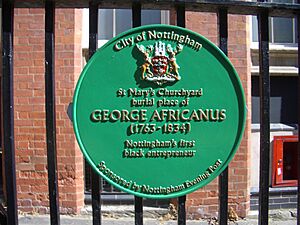George Africanus facts for kids
George John Scipio Africanus (born around 1763 – died 19 May 1834) was a man from West Africa. He was once enslaved but later became a successful businessman in Nottingham, England.
Contents
His Early Life
We don't know much about George Africanus's very early life. He was probably born in 1763. News reports after his death said he was born in a village in Sierra Leone. This place later became a British colony in 1787.
George likely arrived in England in early 1766. On 31 March 1766, he was baptized George John Scipio Africanus. At that time, he was described as a boy living with Benjamin Molineux in Wolverhampton.
Benjamin Molineux started teaching George when he was three years old. After Benjamin Molineux died in 1772, his son, George Molineux, took care of George Africanus. He also made sure George continued his education. As he grew up, Africanus probably worked as a servant for the Molineux family. Later, he became an apprentice to learn how to be a brass founder. This meant he learned to make things from brass.
As an adult, Africanus moved to Nottingham. This city was known to his adopted family.
Starting a Business in Nottingham
George Africanus moved to Nottingham around 1784 when he was about 21. He met a local woman named Esther Shaw. They got married on 3 August 1788 at St. Peter's Church in Nottingham.
Around 1793, George and Esther started their own business. It was called "Africanus' Register of Servants." This was like an employment agency. It helped people find jobs as servants and helped families find servants. They ran the business from their home at 28 Chandlers Lane.
If the business wasn't making enough money, George might have done other jobs. His marriage document from 1788 says he was a brass founder. But other records from that time also list him as a waiter and a labourer. This shows he worked hard to support his family.
George bought their home at 28 Chandlers Lane and other nearby properties in 1829. After George died in 1834, his wife Esther kept running the family business. She continued to run it for many years. When she died in 1853, a newspaper said she had run the Servants' Register Office for over sixty years.
Family Life
George and Esther Africanus had seven children together. However, only one child lived to be an adult. This was their daughter, Hannah.
Hannah married Samuel Cropper in 1825. He was a watch and clock maker. They had three children: Sarah Ann Cropper, George Africanus Cropper, and Esther Africanus Cropper.
Even though no one today has the Africanus last name from George, his family line continued through his daughter Hannah. His granddaughter, Esther Africanus Cropper, later married Charles Edward Turnbull.
George Africanus's will (his last wishes) showed he was not happy with Hannah's marriage to Samuel Cropper. Hannah and Samuel lived apart for some years. After George Africanus died, the 1841 census shows Hannah and Samuel living with Hannah's mother, Esther, on Chandlers Lane. Esther was still working at the servants' office then.
George's will also mentioned that his granddaughter, Sarah Ann Cropper, was "afflicted." This means she had some kind of illness. She died at the age of 17.
His Burial Place and Legacy

For a long time, George Africanus's grave was hard to find. But in 2003, after a lot of careful searching, his grave was found. It is in the churchyard of St. Mary's Church in Nottingham. His wife, Esther, is buried next to him. Their children are buried in a different grave nearby.
Their gravestone has a special message called an epitaph. It says:
In Memory of George Africanus
Who died 19 May 1834
Aged 70 years
Also Ester Africanus, wife of the above
Who died 12 May 1853?
Aged 81 years
Oh cruel death that separated here
A loving father from his daughter dear
Also a tender parent in decline of life
A loving mother and a careful wife
While in this world they did remain
Their latter Days were full of pain
George Africanus is remembered as "Nottingham's first black entrepreneur." In 2003, a green plaque was put up in his memory at St. Mary's churchyard. In 2014, a blue plaque was placed at 28 Chandlers Lane. This marks the place where he lived and ran his business.
In 2007, a special service was held at St. Mary's Church. This was to remember 200 years since the end of the slave trade. A new memorial stone was dedicated to George Africanus. Also, an exhibition was held at Nottingham Council House. It showed documents and pictures from his life.
Today, Nottingham Express Transit tram number 234 is named after George Africanus. This helps keep his memory alive in Nottingham.
Images for kids




